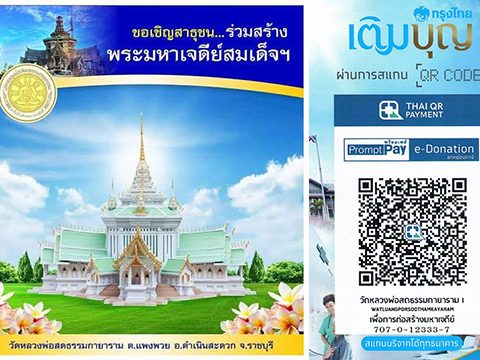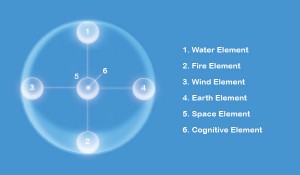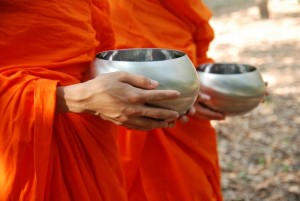
WHAT IS SAMATHA MEDITATION?
Meditation by concentrating the mind is known as Samatha (Serenity) or Concentraion Meditation which removes the Five Hindrances and prepares the mind for Insight or Vipassana Meditation. The Five Hindrances are attachment to sensual desire, ill-will, inactivity or sleepiness, anxiety or restlessness, and doubt.
WHAT IS THE PURPOSE OF CONCENTRATION MEDITATION?
Concentration Meditation combines developing inner peace and concentration together. For most new meditators in today’s hectic world, the immediate objective is to cope with stress and develop personal serenity. Concentration provides this immediately. But, the Buddhist objective is higher. It is raising consciousness to more refined planes through purifying the mind.
WHAT SHOULD WE EXPECT TO ACHIEVE FROM IT?
Direct benefits that can be anticipated include improved mental and physical health and enhanced concentration. The meditator develops distancing from the passions, cravings and delusional attachments which spin us around in circles. This results in a more peacefully happy life and indirectly fosters harmony in the family, the society, and the world. Beyond these external consequences, Concentration Meditation develops the mental tools for effective, objective observation of nature for use in Vipassana Insight Meditation to develop Right Wisdom. In Vipassana, the meditator becomes able to penetrate the Four Noble Truths to see clearly and compare objectively the compound, impermanent, unsatisfactory suffering, and hollow emptiness of this world with the non-compound, eternal, peacefully happy, and ultimately meaningful essence of Nibbana or Nirvana.
WHAT SHOULD WE CONTEMPLATE?
Most broadly, Concentration Meditation is mental training. Lord Buddha listed nine effective subjects for Concentration Meditation. The first four are the key Foundations of Mindfulness – the body, feelings, mind and mental objects. We shall review each of these in detail. The next three are contemplation of old age, sickness, and death. Eighth is meditation that we are all ultimately destined to be separated from what we love, even from our own self. Finally, the ninth theme is that we are all inevitably subject to reap the karmic consequences of our own actions. This is a natural law of cause and effect. There is no way out. Only conscientious good behavior can save us.
WHAT SHOULD WE DO?
Concentration covers three of the eight factors of the Noble Eightfold Path: (1) Right Effort, (2) Right Mindfulness, and (3) Right Concentration. 5.1. Right Effort (Samma-vayama) The first factor, Right Effort, is defined as four exertions:
- 1. The first effort is to prevent the arising of new bad habits, that is, bad actions, speech or thought. Examples of bad actions are intentionally killing living beings, stealing or cheating, sexual misconduct, wrong livelihood, addiction to intoxicants, gambling, and excessive hedonism. Examples of bad speech are lying, backbiting, coarse language and gossiping. Examples of bad thoughts include evil intentions, greed, lust, hot temperedness, hatred, and deluded thinking or holding erroneous beliefs.
- 2. The second effort is the exertion to abandon bad habits, such as these, which have already arisen.
- 3. The third effort is to develop new good habits, that is good actions, speech, and thoughts. Good actions are the opposites of bad actions. For example, treating other beings with sympathy and mercy, generous benevolence, loyalty to one’s spouse, right occupation, clear-headed concentration, and alert awareness of what is good and bad.
- 4. The fourth effort is to maintain good habits which have already arisen, such as those just mentioned.
5.2. Right Mindfulness (Samma-sati) The second factor of the Eightfold Path, Right Mindfulness, is defined as the Four Foundations of Mindfulness: successive inner perception (anupassana) and contemplation of body, feelings, mentality, and dhamma. The Greater Discourse on the Foundations of Mindfulness (the Mahasatipatthana Sutta in the Digha Nikaya) is Lord Buddha’s main sermon on meditation. It lists six methods for mindfulness of the body: Mindfulness of breathing, posture, and actions; Contemplation of body parts as repulsive and as just elements – water, earth, fire or wind; and, nine meditations on corpses, considering that this body too, will become like that. The meditator continues contemplating the body-in-the-body both internally and externally along with the arising and vanishing of phenomena in the body. He remains detached, being aware that there is body, without any clinging. Similarly, the meditator perceives and contemplates the feelings-in-the-feelings as pleasant, painful or neutral, without any clinging. Then, the meditator perceives and contemplates the mind-in-the-mind as lustful, hateful, deluded, distracted, developed, unsurpassed, concentrated, liberated, or the opposites of these states, without any clinging. Finally, the meditator perceives and contemplates the dhamma-in-the-dhamma, specifically: (1) the Five Hindrances; (2) the Five Aggregates; (3) the Six Sense Organs and their sense-objects; (4) the Seven Factors of Enlightenment; and (5) the Four Noble Truths. Lord Buddha concludes, the Four Foundations of Mindfulness are the one way street to the purification of beings for overcoming sorrow and distress and gaining the right path for the realization of Nirvana. 5.3. Right Concentration (Samma-samadhi) Finally, Right Concentration or Samma-samadhi is defined as developing the Four Rupa-jhanas or States of Absorption, going deeper and deeper inside to purify the mind from the Five Hindrances, which obscure clear-sightedness, to transform the normal human senses into powerful instruments of observation, enabling the necessary and sufficient, reliable and valid collection of the relevant data required for direct, lucid comprehension of the true nature of reality. Prince Siddhattha intuitively meditated to the First Jhana when he was only seven years old. Later, when he recognized the futility of seeking enlightenment through self-torture, this memory led him onto the correct path.
WHAT ARE HINDRANCES AND CAUSES?
Samatha meditation controls the Five Hindrances by overcoming each with a counteracting jhāna or Absorption Factor developed by focusing inside [internally], meditating into peacefully happy trance states. First, let’s understand the Five Hindrances. The Five Hindrances are the obstacles which block or cut off the mind from transcending to wisdom. As shown below, they are drowsiness, doubt, ill will, restlessness and sensual desire. The following are the Hindrance Definitions:
- Drowsiness (thīna-middha): sleepiness, drowsiness, laziness, sloth, torpor, languor, stolidity,
- Doubt (vicikicchā): doubt, perplexity, scepticism, indecision, uncertainty,
- Ill Will (byāpāda): ill will, hatred, malevolence, aversion.
- Restlessness (uddhacca-kukkucca): Agitation, worry, anxiety,
- Sensual Desire (kāma-chanda): Sensual desire in fi ve sensual objects which consists of sights, sounds, smells, tastes and touch.
Drowsiness can be caused either by sleepiness or laziness. It includes both mental sluggishness (sloth) and physical sluggishness (torpor). Doubt is usually specifi c to the current meditation procedure, “Am I doing the right thing?” Ill Will can vary from active anger or hatred to simply feeling ill at ease, “Do I really belong here?” Restlessness is usually the familiar racing and fl eeting of the mind from one thought to another, but can also include specifi c worries and anxiety. Finally, Sensual Desire is the enveloping sea that encompasses all the others. We are born into this world of sensual desire because of our enchantment with seeking sensual pleasures. In combination, these Five Hindrances do a good job of confusing our normal thinking and obscuring the true nature of our situation. What are the causes of the Five Hindrances?
- Drowsiness caused by dislike, discontent or aversion (arati),
- Doubt or Uncertainty caused by lack of contemplation (ayonisomanasikāra),
- Ill Will caused by annoyance, anger, hatred, enmity, repulsion, or repugnance (patigha),
- Restlessness caused by being unable to stop the mind from mental distraction or anxiety, lack of peace (cetasoavūpasama).
- Sensual Desire caused by lust or craving for beautiful, pleasing perceptions (subhasaññā).
As shown, drowsiness stems from dislike or discontentment. Doubt comes from lack of contemplation. Ill Will may be due to superficial annoyance, but often refl ects more deeply instilled feelings of anger or hatred. Restlessness indicates our habitual inability to stop the mind due to failure to be able to tune out distractions. However, it can be overcome with mental training. Sensual Desire is caused by the lust and craving for pleasure which pervades our whole approach to life. It is the most deep-seated hindrance and the ultimate target of mental training. The Five Hindrances can be eliminated by the five Jhāna Factors which mentally control or extinguish them.
- Applied thought (vitakka) eliminates drowsiness and laziness (thīna-middha),
- Sustained thought (vicāra) eliminates doubt (vicikicchā),
- Joy (pīti) eliminates ill Will (byāpāda),
- Peaceful Happiness (sukha) eliminates restlessness (uddhacca-kukkucca),
- One-pointed Concentration (ekaggatā) eliminates sensual desire(kāmachanda).
Applied Thought or increased attention overcomes Drowsiness. Sustained Thought or prolonged contemplation overcomes Doubt. Feelings of Joy (pīti) overcome Ill Will and peaceful happiness overcomes restlessness. One-pointed Concentration overcomes sensual desire and gives rise to the neutral Feeling of Equanimity which appears in the deepest jhāna state. Applied Thought (vitakka) is contemplation of feelings or sensations. Its characteristic is directing the mind through attention to be focused on an object. Its function is gathering and maintaining and understanding and analyzing where its result is leading the mind. Sustained Thought (vicāra) means considering the object as its characteristic, its function is keeping the mind and mental concomitants occupied with the object, and its result is keeping the mind anchored on that object. Vitakka and vicāra always go together, but vitakka arises before vicāra. Vitakka is cruder than vicāra. It is like the sound of a bell when struck, while vicāra is like the humming sound afterwards. Joy or Rapture (pīti) has joyfulness as its characteristic. Its function is physically and mentally suffusing, and its result is physical and mental glow. There are fi ve kinds of pīti:
- Minor Thrill,
- Momentary or Instantaneous Joy,
- Showering Joy, like a wave hitting the shore,
- Uplifting joy, and
- Suffusing joy.
Peaceful Happiness (sukha) eats or eases away physical and mental discomfort. Its characteristic is gladness, its function is increasing its components and its result is generosity. Pīti is pleasure that arises. Sukha is experiencing the pleasure. When the mind has pīti, it also has sukha, but when the mind has sukha, that does not mean that it also has pīti. For example, pīti arises immediately when a man without food traveling in the desert finds an oasis or water. Only when he reaches the shade of the oasis or drinks the water, does sukha (happiness) arise. In the following quotes, Lord Buddha describes meditating to overcome the Five Hindrances (Majjhima-nikaya 12/469-474/502- 507): Monks, what needs to be done further? A monk in this Norm-discipline will find a quiet shelter which is a forest, the root of a tree, a mountain, a mountain valley, a cave, a cemetery, a thorn forest, an open-air area or a heap of straw. He returns from gathering alms and after his meal he sits crosslegged, upright, maintaining mindfulness. If he eliminates covetousness and develops a mind without covetousness, he will purify the mind from covetousness. If he eliminates violence and ill will, he is without thought of ill will and he has compassion, he will purify the mind from ill will. If he eliminates sloth, he is free of sloth, and contemplates the light of mindfulness and will thus purify the mind from sloth. If he eliminates restlessness, his mind will not be distracted and he will become tranquilized, mindful. He will purify the mind from restlessness. If he eliminates doubt, he will be free from doubt, and fi rm in the foundation of wholesome states, he will have purifi ed the mind from doubt. A monk contemplates and sees these Five Hindrances, which have not yet been eliminated, such as a debt, a disease, a prison, as slavery and then, traveling along a remote path, he contemplates and sees these Five Hindrances which become eliminated and, then, are replaced as being without debt, being without disease, being free from prison, being liberated and being in a secure place. In the following quote, Lord Buddha describes the four rūpajhānas (Majjhima-nikaya 12/469-474/502-507): A monk eliminates the Five Hindrances which are defilements of the mind that weaken wisdom, and he calms his mind, becoming freed from sensedesire and unwholesome states, and, then he attains the First Jhāna. He has Applied Thought (vitakka), Sustained Thought and joy … Again, a monk attains the second jhāna and his inner mind is purifi ed and becomes one-pointed because Applied Thought (vitakka) and sustained thought (vicāra) are eliminated. There are only joy and happiness of concentration … Again, a monk who has equanimity and mindfulness moderates happiness with both mind and body. Because joy is eliminated he attains the Third Jhāna. The Ariyas (Noble Ones) praise those who attain this jhāna as living happily, with equanimity and mindfulness… Again, a monk who attains the Fourth Jhāna has no suffering or happiness because happiness and suffering are eliminated and his former sorrow is eliminated. There is only equanimity which purifies mindfulness. The pure mind suffuses every part of his whole body, like a man whose head is covered by a white cloth. There is no part of his body untouched by the white cloth. When the meditator concentrates the mind to stop still firmly, so well that he or she can attain a counterpart sign or patibhāga-nimitta deeply seated in both eye and mind, then all fi ve jhāna factors will appear together to suppress the Five Hindrances. This is the first jhāna. When the meditator trains the mind to stop firmly even more still and deeper, the mind lets go of the coarsest factors of applied thought (vitakka) and sustained thought (vicāra), only rapture or joy (pīti), peaceful happiness (sukha) and one-pointed concentration (ekaggatā) remain. This is the second jhāna. When the meditator trains the mind to stop more fi rmly still, and it becomes more refi ned, the mind refi nes rapture or joy, and only peaceful happiness and one-pointed concentration remain. This is the third jhāna. When the meditator trains the mind to stop still fi rmly even deeper and more refined, the mind drops peaceful happiness, so that only one-pointed concentration remains and the mind becomes still in equanimity (upekkhā). This is samādhi or concentration of the fourth jhāna.
WHAT ARE THE FOUR JHANAS OR STATES OF ABSORPTION?
The normal human mind is blurred by Five Hindrances.The Five Hindrances, are Sleepiness or Laziness (Thina-middha), Doubt (Vicikiccha), Ill Will (Byapada), Restlessness or Worry (Uddhacca-kukkucca), and Sensual Desire (Kamachanda). As the meditator approaches absorption, he or she perceives spontaneous Nimitta or signs of progress which are the tools of Jhana. First, the meditator perceives Parikamma-nimitta or preliminary signs, signifying temporary or weak (khanika) concentration. With practice, these develop into an intermediate sign or Uggaha-Nimitta, when the sphere lasts for a short time. This signifies substantial or Upacara Samadhi, which is already getting close to stable concentration. Finally, when the mind is permanently in the Nimitta, the meditator comes to perceive the the Counterpart Sign (Patibhaga-nimitta), signifying permanent concentration. At this stage, the meditator can control the Nimitta (a mental image or meditation sign), moving it and changing its size. At this point, the mind develops the Five Jhana Virtues, each of which purifies the mind of the corresponding Hindrance. The Jhana Virtues are Applied Thought or Attention (Vitakka) which purifies drowsiness or laziness; Sustained Thought or Contemplation (Vicara) which purifies doubt; Joy or Rapture (Piti) which purifies hatred or ill will; Peaceful Happiness (Sukha) which purifies Restlessness or Worry; and One-pointed Concentration (Ekaggata) which purifies Sensual Desire or Enchantment. These five Jhana Virtues all develop together quickly by the First Jhana level. Applied Thought begins with the Learning Sign (Uggaha-nimitta), and the rest follow quickly with the Counterpart Sign (Patibhaga-nimitta). When concentration and absorption or Jhana develop further to the point where the mind no longer pays attention to either Applied or Sustained Thought, the meditator ascends into the Second Jhana, where only Joy, Happiness and One-pointed Concentration remain active. Next, with further concentration and absorption, the mind no longer pays attention to Joy, and the meditator rises into the Third Jhana with only Happiness and One-pointed Concentration. Thereafter, with further concentration and absorption, the mind no longer pays attention to Happiness, and there remains only One-pointed Concentration, which is joined by a new Virtue, Equanimity – neither happiness nor suffering. This is the Fourth Jhana.
HOW DOES THE MEDITATOR, THEN, CONTINUE TO REALIZE THE FOUR FOUNDATIONS OF MINDFULNESS IN SAMATHA-VIPASSANA MEDITATION?
Concentration of the mind at the 1st, 2nd, 3rd, and 4th levels of Jhana causes development of a stable, concentrated mind purified from all hindrances. This is the necessary and sufficient preparation for direct comprehension of the Four Foundations of Mindfulness. The Pali wording for the Four Foundations of Mindfulness is Anupassana of the body-in-the-body, feelings-in-the-feelings, mind-in-the-mind, and Dhamma-in-the-Dhamma. Anupassana means step-by-step inner perception more than “contemplation.” In step-by-step Meditation, this is carried out by actually seeing, knowing, and becoming successively more and more refined, purer and purer inner bodies, taking on their corresponding feelings, mental states and Dhamma. Dhamma is usually rendered as mental objects or phenomena. As we have already noted, this refers to Lord Buddha’s teachings: the Five Hindrances, Five Aggregates; Six Sense Organs and their sense-objects, the Seven Factors of Enlightenment, and the Four Noble Truths. As the meditator achieves the higher and higher levels of consciousness associated with the purer and more refined inner bodies, he or she attains deeper and deeper understanding of these teachings. These more and more refined inner bodies are reborn or conceived spontaneously in natural accordance with Dependent Origination, as the meditator focuses the purified mind at the center of the center of the crude outer body. For example, in the First Jhana, when one focuses attention at the center of the center of the body, the mind and Dhamma-in-the-Dhamma become purer and purer causing the Refined Human Body to emerge. Ignorance is still present but less active, and the high virtues of Dana (sacrifice), Sila (morality), and Bhavana (meditation) cause more refined and purer bodies to appear, together with their more blissful feelings (Sukha Vedana), elevated mentality, and deeper comprehension of Dhamma. The meditator enters and becomes each body, in turn, using the higher capability of the new, elevated mind to reach the next body. The bodies are just the visible, attainable base supporting the higher virtue – the happier feelings, elevated mind, and deeper Dhamma. The meditator is drawn naturally to leave the crude body behind and become the more blissful, refined body with purer mind and more profound Dhamma. Having become the Refined Human Body, meditation continues, concentrated at the center of the center of the Refined Human Body until the meditator perfects the virtues of this new, refined body and mind. Then, the center of the Refined Body expands itself and the next purer body the Celestial Body emerges with its even higher mental state of celestial virtues. The meditator becomes the Celestial Body, causing his or her mental phenomena to become even purer. In the same way, purer and purer refined bodies continue to pop up along with their more and more elevated feelings, purer and purer minds and more and more profound Dhamma, brought on by the higher and higher Morality or Sila, Concentration or Samadhi and Wisdom or Pañña of the successive bodies, which are all higher than the human level. The meditator continues moving up step-by-step through all eight worldly bodies: Human, Refined Human, Celestial, Refined Celestial, Brahman, Refined Brahman, Formless Brahman, and the Refined Formless Brahman Body, which is the most refined of all the worldly bodies. The meditator becomes each body and uses its purer virtue and higher mentality to meditate up to the next level. When the meditator stops perfectly still at the center of the Refined Formless Brahman Body, the center expands itself and he or she meditates to Dhammakaya. “Dhamma” means Noble Level Virtue and Kaye means body or base of the virtue. Lord Buddha said “Dhammakaya itipi” which means “Dhammakaya is me.” The Dhammakaya Bodies support the supra-mundane virtues of the Noble Disciples, which form the path from the worldly level to Nibbana. The body is what we can see, know and become. Each Dhammakaya is a radiant, crystal clear Buddha statue, sitting in meditation position inside a crystal sphere. Sitting down cross-legged, the statue is roughly the same height and width across the lap. There are a total of ten basic Dhammakaya, in pairs of crude and refined bodies, corresponding to path and fruit. The First pair are the crude and refined Gotrabhu Dhammakaya which are roughly nine meters in diameter. These are called “Noble State Wisdom.” They are not yet at the Noble Disciple level. So long as the meditator cannot cut at least the first three of the Ten Fetters, he will still just stay in the Gotrabhu mentality, not yet to the Noble level. Beyond Gotrabhu, one meditates to the level of the Nine Noble Virtues cited by Lord Buddha as four paths, plus four fruits, and plus one Nibbana. The Dhammakaya are: Sotapanna or Stream Enterer, Refined Sotapanna, Sakadagami or Once Returner, Refined Sakadagami, Anagami or Non-Returner, Refined Anagami, Arahant or Dhammakaya Saint, and Refined Arahant, which is 40 meters in height and width. Finally, following this path, one can meditate to experience Nirvana temporarily.
HOW DOES THIS CONCENTRATION MEDITATION PRACTICE PREPARE THE MEDITATOR FOR INSIGHT MEDITATION?
At the Noble Disciple level, Concentration and Insight Meditation already begin to merge. The meditator develops super normal tools for effective and efficient Insight Meditation. These powers or Abhiñña such as the Angel Eye and Angel Ear, enable one to perceive the most refined beings and phenomena of the universe, which are transparent to the human eye and beyond the range of the human ear. One also develops the mental microscope and the mental telescope which enable seeing the whole universe and beyond to Nirvana. These are the tools which facilitate Concentration-Insight Meditation and enable one to follow Lord Buddha’s development of the Three Vijja (Transcendental Knowledge) which he attained on enlightenment night.
THE BENEFIT OF RIGHT CONCENTRATION
Right concentration develops Supra-mundane Knowledge (vijjā) and wisdom (paññā). Practicing samatha-bhāvanā, training the mind to stop still firmly concentrated to attain the jhānas, from the first jhāna to the fourth jhāna, suppresses the Five Hindrances. This is the first step towards the transcendental knowledge that eliminates ignorance (avijjā), the root cause underlying all suffering. It makes the mind clear and ready for the task of developing transcendental knowledge and wisdom to penetrate the Four Noble Truths. This is called Right Concentration (sammā-samādhi), one component of the Noble Eightfold Path.
The Threefold Knowledge
The following are Lord Buddha’s descriptions of the threefold knowledge (vijjā) for which jhāna attainment provides the foundation. These states permit overcoming ignorance and penetrating the Four Noble Truths (Majjhima-nikaya 12/475-477/414-415).
[Knowledge of Past Lives] Monks, when his mind is concentrated, purified, clear, without defilement, without mental depravity, gentle, workable, fi rm and steady, he will direct his mind to pubbenivāsānussatiñāna [Knowledge of Past Lives]. He is recalling where he used to live in the past, in one birth, two births, … many lives which used to be including ākāra [such as appearance, manner countenance, cause, reason, purpose] and uddesa [such as name, parents]. Just as a man goes from his own house to another, from that house to others and back to his own house again. He recollects that he went from his own house to that house, in that house, how he stood, sat, spoke, became silent, and went from that house to another. Then, he went from that house to others again. Monks, thus, he recollects his past lives, one birth, two births … many lives which used to be including ākāra [such as appearance, manner countenance, cause, reason, purpose] and uddesa
[such as name, parents
[Knowledge of Decease and Rebirth of Beings]
Monks, when his mind is concentrated, purified, clear, without defilement, without mental depravity, gentle, workable, fi rm, and steady, he will direct his mind to cutūpapātañāna (Knowledge of Decease and Rebirth of Beings): He sees beings passing away, being reborn, inferior, refined, of good complexion, crude complexion, fortunate, misfortunate with the pure divine eyes which are beyond human eyes … he understands beings depending on kamma (karma). Just as in a castle at the four-way intersection in the middle of a city. A man with good sight standing upon the castle can see humans going to a house, leaving a house, walking, coming and traveling. Like that a monk sees beings passing away, being reborn, inferior, refi ned, of good complexion, crude complexion, fortunate, misfortunate with the pure divine eyes which are beyond human eyes … he understands beings depending on kamma.
[Knowledge of Destruction of Mental Intoxications] Monks, when his mind is concentrated, purified, clear, without defilement, without mental depravity, gentle, workable, fi rm, and steady, he will direct his mind to āsavakkhayañāna (Knowledge of Destruction of Mental Intoxications). He penetrates to find that this is Suffering (dukkhya), this is the Cause of Suffering (samudaya), this is the Cessation of Suffering (nirodha), this is the Path leading to the Cessation of Suffering (magga). These are mental intoxications (āsava). This is a cause of mental intoxications. This is the cessation of mental intoxications. This is the path leading to the cessation of mental intoxications. When he penetrates this, his mind is emancipated from āsava of sense-desire, āsava of becoming and āsava of ignorance. When his mind has been emancipated, there will be the knowledge that this is emancipation. Birth ends. The chaste life is over. The obligation has been done. There is no more obligation. Just as at mountain pool, with pure and limpidwater, a man with good eyes who stands at the edge of the pool of water can see oyster shells, pebbles, tiles and fi sh which stop or move. He thinks that in the pool of water with pure and limpid-water, there are oyster shells, pebbles, tiles and fi sh which stop or move. This is the same as the monk who penetrates that this is suffering, this is the cause of suffering, … He will know that rebirth ends. The chaste life is over. The obligation has been done. There is no more obligation. He has done what must be done. With this threefold knowledge, the meditator can overcome ignorance, penetrate the Four Noble Truths completely, and attain transcendental wisdom.
The Benefits of Right Concentration
Lord Buddha said the benefits of Right Concentration are (Khuddaka-nikaya 25/35/65): There is no jhāna (absorption factors) for one who is without wisdom and no wisdom for one who is without jhāna. He who has both jhāna and wisdom is, indeed, close to Nibbāna.









 ไลน์ "@wlps" เพื่อรับข่าวสารจากทางวัด
ไลน์ "@wlps" เพื่อรับข่าวสารจากทางวัด
